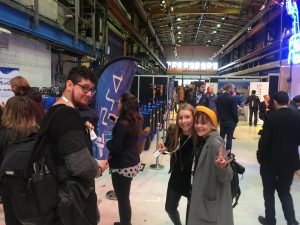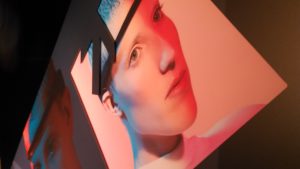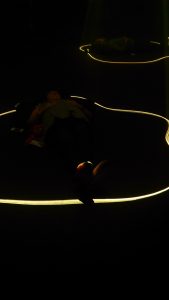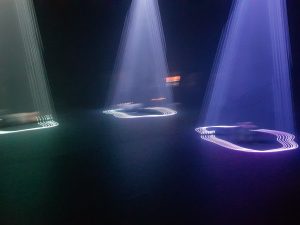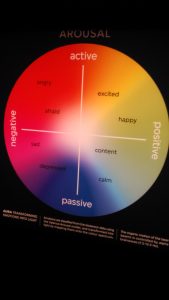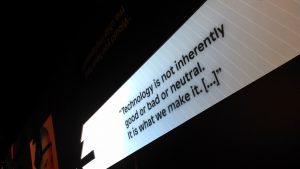At the beginning of the third sprint we spent few days outside of the MediaLAB to gather some inspiration for redefining our concept.
Dutch VR Days
On Thursday 26th of October we visited the Dutch VR Days where we got a chance to test the newest VR headsets (including the 8K Pimax, the only one which didn’t make Chris feel dizzy) as well as feel the overwhelming excitement in the growing field of VR and AR.
For the start we all lined up to test the Playstation VR. Rory got a chance to play a deep ocean game where the user was transported into the water where gradually by drowning down the environment got darker and fish bigger. At some point (apparently when the sharks appeared) she felt so scared that she needed to take the whole headset off and escape from the VR environment. Also Janina needed to face her fears by playing a VR simulation of a “hall of a horror” – the one famous and familiar from the amusement parks (she also screamed at the beginning of the game and felt pretty embarrassed about that). Agnetha played a shooting game in Playstation but she wasn’t really convinced about the quality of the game as there were a lot of glitches.
We also tested some other scary games in order to get some new insights to redefine and -design our concept. Something we found impressive was a scary game called “Hell Eluja” which was built interactive by adding a tablet to control the VR experience real time. The rules of the game were quite simple as the tablet controller (aka. the player) was asked to find the user experiencing the VR by adding cameras, and then implementing some monsters to catch and kill the user. Rory totally freaked out, and at the end we found her under the table. One idea for our concept could be to let the therapist “control” the exposure therapy based on her behavioral reactions.
In addition to the exploration of different kind of VR headsets and environments (including a physical water pontoon where one could swim with dolphins!?), and other crazy, although genius ideas how to make the most out of VR (check for example Sensiks), we also sat down for a while and listened few experts from the field. Isabel Tewes, now working as a developer strategist at Oculus, gave a speech about the user engagement. Even though the topic was not directly relevant for our project (since at the end we hope the user don’t need to get back to our VR environment) we were able to collect few points that we maybe should take into account when redesigning our concept.
Firstly, Tewes mentioned the importance of the first impression in order to engage the user to the VR environment. In fact, the first seconds in VR are very crucial for the immersion – which of course is necessary in our case of exposure therapy. As Tewes noted, there needs to be some elements or “magic” that helps us to engage in the VR environment. Interestingly, in all of her given examples the engagement was strongly build up by other imaginary subjects in the VR environment (see one of her examples about Rick and Morty: Virtual Rick-ality). This strongly reminded us about “Henry”, a VR experience of a hitchcock’s birthday, where the user is empathising and embodying him/herself to the VR environment even though it is cartoon and fictionable. By taking into account all of these examples, we assume something worth of study could be the presence of a third person or even a fictional subject in a VR environment, and its relation to empathy, engagement and immersion in virtual reality.
Dutch Design Week @Eindhoven
On the same Friday (27th of October) we took a train to Eindhoven to visit the Dutch Design Week and get some more inspiration. The exhibition “We know how you feel tonight” by VPRO Medialab was one of the events that got our attention from the DDW program.
At the entrance the exhibition took a quick look into the short history of emotional tracking. It made the visitor to question his/her emotional data, as well as its privacy, openness and future. The visitors were allowed to give some feedback by typing comments either to the sheets of “Fears” or “Hopes” concerning the use of their emotional data.
After the short introduction we passed through the big black curtains into a dark room. The colorful auras around the people who were lying down in the floor created a bit spooky feeling. By taking a closer look, we were able to see that they were having different kind of sensors attached to them. The EEG sensor in their forehead was programmed to listen and record the biofeedback from their bodies – and transport them out of the noise of our footsteps into somewhere. But who knows where?
The emotional aura, appearing in different colors according to the emotional data of the users, was build according to the Russell’s Circumplex Model of Affect (1980) which is already familiar to us. For the EGG they were using the MUSE sensor which is developed especially for the use of meditation. However, interpreting the data and visualize it is never an easy task. According to the exhibition builders, the emotional aura, which was made visible by the lasers was relatively difficult to build up. Overall, the exhibition was worth visiting and we were especially happy that a lot of space was left for critical thinking. Even the experience as an observer raised a different kind of and sometimes overlapping emotions, feelings and questions.
How can you be sure the emotional aura is build according to the direct biofeedback of the person? Is there somebody behind the recording machine saving the emotional data of the user – and if yes – how it will be reused in the future? Are those people here voluntarily or did somebody pay them to come here? How willing would you be to be attached to those sensors, and visibly showing your “emotions” to other people? Does the visualization of the emotional biofeedback create intimacy between the people?
By digging into the last question, we believe that the intimacy of the biofeedback might be used in the future. From the therapy point of view the visualization of the emotional data can help to build an empathetic environment, which then again can help us to take different kind of perspectives. For example, a film producer Chris Milk is calling virtual reality as an “ultimate empathy machine”, something which he also explored by producing a project for United Nations. A 360 degree film “Clouds Over Sidra” transports the user to follow a life of a 12-year old girl refugee girl in Syria. In his TED talk Milk argues that especially the empathy activated via VR can help us to change this world. However, the notion of empathy is raising controversial debates around the field. Is empathy something special for VR or more a question about the immersiveness and the different routes for that? As we argued in our previous blog post, also the embodiment of the user can lead to immersion and engagement in virtual reality, as well as the state of flow.
The VPRO Medialab states in their website “Our emotions have been our own until now, but it seems that this is about to change”. Do you agree or disagree?




